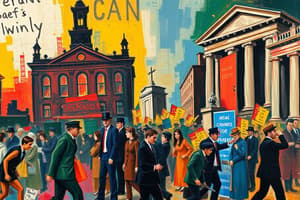Podcast
Questions and Answers
What caused the alarming rates of bank failures in the early 1930s?
What caused the alarming rates of bank failures in the early 1930s?
As the economic depression deepened, banks began to fail at alarming rates.
What was the average number of bank failures each year during the 1920s?
What was the average number of bank failures each year during the 1920s?
70 banks
How many banks failed in 1933 alone?
How many banks failed in 1933 alone?
4,000 banks
What was significant about the stock market crash of 1929?
What was significant about the stock market crash of 1929?
By what percentage did the Dow Jones Industrial Average drop during the 1929 crash?
By what percentage did the Dow Jones Industrial Average drop during the 1929 crash?
What impact did agriculture have on the Great Plains during the 1920s?
What impact did agriculture have on the Great Plains during the 1920s?
What is the Dust Bowl associated with?
What is the Dust Bowl associated with?
How did U.S. exports to Europe change during the Great Depression?
How did U.S. exports to Europe change during the Great Depression?
What was the effect of unequal distribution of income during the 1920s?
What was the effect of unequal distribution of income during the 1920s?
What was one cause of the depression in the 1930s?
What was one cause of the depression in the 1930s?
Flashcards are hidden until you start studying
Study Notes
Bank Failure
- Early 1930s economic depression led to significant bank failures as farmers' spending decreased.
- Average annual bank failures in the 1920s were around 70; after the 1929 crash, 744 banks failed in the first ten months of 1930.
- A total of 9,000 banks failed throughout the 1930s, with 4,000 failures occurring in 1933 alone.
- By 1933, bank failures resulted in depositors losing $140 billion.
Stock Market Crash (1929)
- The stock market crash began on October 24, 1929, over four days, marking the worst decline in U.S. history.
- The Dow Jones Industrial Average fell by 25%, losing $30 billion in market value—equivalent to $396 billion today.
- This market collapse eroded confidence in Wall Street and contributed significantly to the onset of the Great Depression.
Agriculture
- The combination of extended farming areas, new equipment, and drought during the 1920s adversely affected the Great Plains.
- Farmers overextended credit to purchase equipment and seeds, leading to increased crop production but falling prices and profits.
- This cycle hindered farmers' ability to repay loans, exacerbating their financial difficulties.
Dust Bowl
- The Dust Bowl was characterized by severe soil erosion and loss of vegetation, particularly affecting Oklahoma, Kansas, and northern Texas.
- Resulting from drought and poor farming practices, it forced many inhabitants to relocate in search of better living conditions.
Exports
- The Great Depression resulted in a significant drop in U.S. exports due to reduced cooperation with Europe and global economic turmoil.
- Exports to Europe plummeted from $2,341 million in 1929 to $784 million in 1932, demonstrating the Depression's widespread impact.
Unequal Distribution of Income
- During the 1920s, wealth concentration increased while the majority of families became poorer; over 70% earned less than $2,500 annually.
- Many families could not afford basic household goods, contributing to economic stagnation.
- Only half of city homes had electrical lights or heating, and just one in ten had an electric refrigerator, reflecting stark inequality.
Credit
- Excessive credit expansion in the 1920s contributed to the Depression of the 1930s.
- Banks' overextension created a temporary economic boom followed by a severe bust, leading to widespread bank withdrawals and failures.
Studying That Suits You
Use AI to generate personalized quizzes and flashcards to suit your learning preferences.




